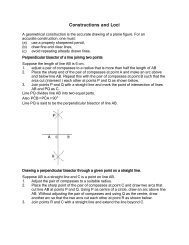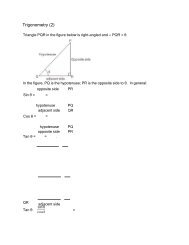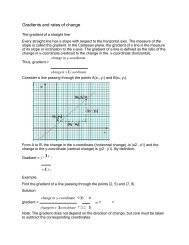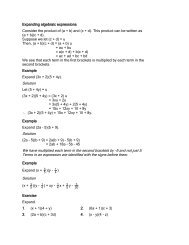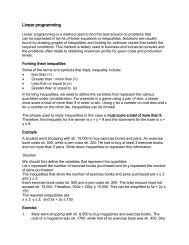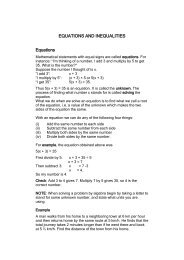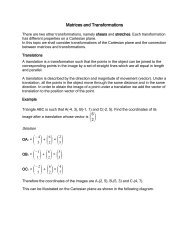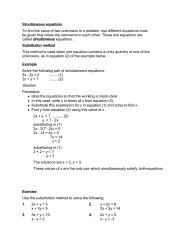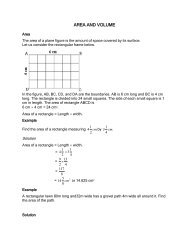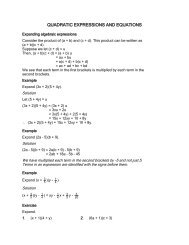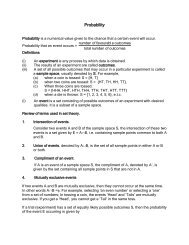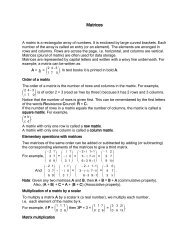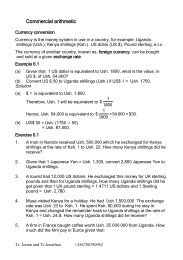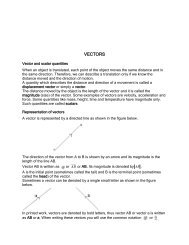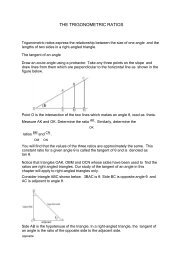23
Create successful ePaper yourself
Turn your PDF publications into a flip-book with our unique Google optimized e-Paper software.
© 2007 The McGraw-Hill Companies, Inc. All rights reserved.<br />
Eighth Edition<br />
CHAPTER<br />
VECTOR MECHANICS FOR ENGINEERS:<br />
STATICS<br />
Ferdinand P. Beer<br />
E. Russell Johnston, Jr.<br />
Statics of Particles<br />
Lecture Notes:<br />
J. Walt Oler<br />
Texas Tech University
ighth<br />
dition<br />
Vector Mechanics for Engineers: Statics<br />
Contents<br />
Introduction<br />
Resultant of Two Forces<br />
Vectors<br />
Addition of Vectors<br />
Resultant of Several Concurrent<br />
Forces<br />
Sample Problem 2.1<br />
Sample Problem 2.2<br />
Rectangular Components of a Force:<br />
Unit Vectors<br />
Addition of Forces by Summing<br />
Components<br />
Sample Problem 2.3<br />
Equilibrium of a Particle<br />
Free-Body Diagrams<br />
Sample Problem 2.4<br />
Sample Problem 2.6<br />
Rectangular Components in Space<br />
Sample Problem 2.7<br />
© 2007 The McGraw-Hill Companies, Inc. All rights reserved.<br />
2 - 2
ighth<br />
dition<br />
Vector Mechanics for Engineers: Statics<br />
Introduction<br />
• The objective for the current chapter is to investigate the effects of forces<br />
on particles:<br />
- replacing multiple forces acting on a particle with a single<br />
equivalent or resultant force,<br />
- relations between forces acting on a particle that is in a<br />
state of equilibrium.<br />
• The focus on particles does not imply a restriction to miniscule bodies.<br />
Rather, the study is restricted to analyses in which the size and shape of<br />
the bodies is not significant so that all forces may be assumed to be<br />
applied at a single point.<br />
© 2007 The McGraw-Hill Companies, Inc. All rights reserved.<br />
2 - 3
ighth<br />
dition<br />
Vector Mechanics for Engineers: Statics<br />
Resultant of Two Forces<br />
• force: action of one body on another;<br />
characterized by its point of application,<br />
magnitude, line of action, and sense.<br />
• Experimental evidence shows that the<br />
combined effect of two forces may be<br />
represented by a single resultant force.<br />
• The resultant is equivalent to the diagonal of<br />
a parallelogram which contains the two<br />
forces in adjacent legs.<br />
• Force is a vector quantity.<br />
© 2007 The McGraw-Hill Companies, Inc. All rights reserved.<br />
2 - 4
ighth<br />
dition<br />
Vector Mechanics for Engineers: Statics<br />
Vectors<br />
• Vector: parameters possessing magnitude and direction<br />
which add according to the parallelogram law. Examples:<br />
displacements, velocities, accelerations.<br />
• Scalar: parameters possessing magnitude but not<br />
direction. Examples: mass, volume, temperature<br />
• Vector classifications:<br />
- Fixed or bound vectors have well defined points of<br />
application that cannot be changed without affecting<br />
an analysis.<br />
- Free vectors may be freely moved in space without<br />
changing their effect on an analysis.<br />
- Sliding vectors may be applied anywhere along their<br />
line of action without affecting an analysis.<br />
• Equal vectors have the same magnitude and direction.<br />
• Negative vector of a given vector has the same magnitude<br />
and the opposite direction.<br />
© 2007 The McGraw-Hill Companies, Inc. All rights reserved.<br />
2 - 5
ighth<br />
dition<br />
Vector Mechanics for Engineers: Statics<br />
Addition of Vectors<br />
• Trapezoid rule for vector addition<br />
• Triangle rule for vector addition<br />
B<br />
C<br />
C<br />
• Law of cosines,<br />
2<br />
2<br />
R P Q<br />
<br />
R P Q<br />
2<br />
2PQ<br />
cos B<br />
B<br />
• Law of sines,<br />
sin A sin B<br />
<br />
Q R<br />
<br />
sin C<br />
A<br />
• Vector addition is commutative,<br />
<br />
P Q Q P<br />
• Vector subtraction<br />
© 2007 The McGraw-Hill Companies, Inc. All rights reserved.<br />
2 - 6
ighth<br />
dition<br />
Vector Mechanics for Engineers: Statics<br />
Addition of Vectors<br />
• Addition of three or more vectors through<br />
repeated application of the triangle rule<br />
• The polygon rule for the addition of three or<br />
more vectors.<br />
• Vector addition is associative,<br />
<br />
P Q S P Q S P <br />
Q<br />
S <br />
<br />
<br />
• Multiplication of a vector by a scalar<br />
© 2007 The McGraw-Hill Companies, Inc. All rights reserved.<br />
2 - 7
ighth<br />
dition<br />
Vector Mechanics for Engineers: Statics<br />
Resultant of Several Concurrent Forces<br />
• Concurrent forces: set of forces which all<br />
pass through the same point.<br />
A set of concurrent forces applied to a<br />
particle may be replaced by a single<br />
resultant force which is the vector sum of the<br />
applied forces.<br />
• Vector force components: two or more force<br />
vectors which, together, have the same effect<br />
as a single force vector.<br />
© 2007 The McGraw-Hill Companies, Inc. All rights reserved.<br />
2 - 8
ighth<br />
dition<br />
Vector Mechanics for Engineers: Statics<br />
Sample Problem 2.1<br />
SOLUTION:<br />
The two forces act on a bolt at<br />
A. Determine their resultant.<br />
• Graphical solution - construct a<br />
parallelogram with sides in the same<br />
direction as P and Q and lengths in<br />
proportion. Graphically evaluate the<br />
resultant which is equivalent in direction<br />
and proportional in magnitude to the the<br />
diagonal.<br />
• Trigonometric solution - use the triangle<br />
rule for vector addition in conjunction<br />
with the law of cosines and law of sines<br />
to find the resultant.<br />
© 2007 The McGraw-Hill Companies, Inc. All rights reserved.<br />
2 - 9
ighth<br />
dition<br />
Vector Mechanics for Engineers: Statics<br />
Sample Problem 2.1<br />
• Graphical solution - A parallelogram with sides<br />
equal to P and Q is drawn to scale. The<br />
magnitude and direction of the resultant or of<br />
the diagonal to the parallelogram are measured,<br />
R<br />
98 N 35<br />
• Graphical solution - A triangle is drawn with P<br />
and Q head-to-tail and to scale. The magnitude<br />
and direction of the resultant or of the third side<br />
of the triangle are measured,<br />
R 98 N 35<br />
© 2007 The McGraw-Hill Companies, Inc. All rights reserved.<br />
2 - 10
ighth<br />
dition<br />
Vector Mechanics for Engineers: Statics<br />
Sample Problem 2.1<br />
• Trigonometric solution - Apply the triangle rule.<br />
From the Law of Cosines,<br />
R<br />
2<br />
P<br />
<br />
sin A<br />
<br />
Q<br />
sin A <br />
2<br />
Q<br />
2<br />
2PQ<br />
cos B<br />
2 2<br />
40N 60N 240N60Ncos155<br />
R 97.73N<br />
From the Law of Sines,<br />
sin B<br />
R<br />
Q<br />
sin B<br />
R<br />
sin155<br />
A 15.04<br />
20 A<br />
35. 04<br />
60N<br />
97.73N<br />
© 2007 The McGraw-Hill Companies, Inc. All rights reserved.<br />
2 - 11
ighth<br />
dition<br />
Vector Mechanics for Engineers: Statics<br />
Sample Problem 2.2<br />
A barge is pulled by two tugboats.<br />
If the resultant of the forces<br />
exerted by the tugboats is 5000 N<br />
directed along the axis of the<br />
barge, determine<br />
a) the tension in each of the ropes<br />
for = 45 o ,<br />
b) the value of for which the<br />
tension in rope 2 is a minimum.<br />
SOLUTION:<br />
• Find a graphical solution by applying the<br />
Parallelogram Rule for vector addition. The<br />
parallelogram has sides in the directions of<br />
the two ropes and a diagonal in the direction<br />
of the barge axis and length proportional to<br />
5000 N.<br />
• Find a trigonometric solution by applying<br />
the Triangle Rule for vector addition. With<br />
the magnitude and direction of the resultant<br />
known and the directions of the other two<br />
sides parallel to the ropes given, apply the<br />
Law of Sines to find the rope tensions.<br />
• The angle for minimum tension in rope 2 is<br />
determined by applying the Triangle Rule<br />
and observing the effect of variations in .<br />
© 2007 The McGraw-Hill Companies, Inc. All rights reserved.<br />
2 - 12
ighth<br />
dition<br />
Vector Mechanics for Engineers: Statics<br />
Sample Problem 2.2<br />
• Graphical solution - Parallelogram Rule<br />
with known resultant direction and<br />
magnitude, known directions for sides.<br />
T1 3700 N T2<br />
<br />
2600 N<br />
• Trigonometric solution - Triangle Rule<br />
with Law of Sines<br />
T 1 T<br />
2 5000 N<br />
<br />
sin 45 sin30<br />
sin105<br />
T1<br />
3660 N T2<br />
<br />
2590 N<br />
© 2007 The McGraw-Hill Companies, Inc. All rights reserved.<br />
2 - 13
ighth<br />
dition<br />
Vector Mechanics for Engineers: Statics<br />
Sample Problem 2.2<br />
• The angle for minimum tension in rope 2 is<br />
determined by applying the Triangle Rule<br />
and observing the effect of variations in .<br />
• The minimum tension in rope 2 occurs when<br />
T 1 and T 2 are perpendicular.<br />
T2<br />
T1<br />
5000 Nsin<br />
<br />
30<br />
5000 Ncos<br />
<br />
30<br />
T 2 2500 N<br />
T 1 4330 N<br />
90 30<br />
60<br />
© 2007 The McGraw-Hill Companies, Inc. All rights reserved.<br />
2 - 14
ighth<br />
dition<br />
Vector Mechanics for Engineers: Statics<br />
Rectangular Components of a Force: Unit Vectors<br />
• May resolve a force vector into perpendicular<br />
components<br />
<br />
so that<br />
<br />
the resulting parallelogram is a<br />
rectangle. F x and F y are referred to as rectangular<br />
vector components and<br />
<br />
F F x F y<br />
<br />
• Define perpendicular unit vectors i and j which are<br />
parallel to the x and y axes.<br />
• Vector components may be expressed as products of<br />
the unit vectors with the scalar magnitudes of the<br />
vector components.<br />
<br />
F F i F j<br />
x<br />
y<br />
F x and F y are referred to as the scalar components of<br />
F <br />
© 2007 The McGraw-Hill Companies, Inc. All rights reserved.<br />
2 - 15
ighth<br />
dition<br />
Vector Mechanics for Engineers: Statics<br />
Addition of Forces by Summing Components<br />
• Wish to find the resultant of 3 or more<br />
concurrent forces,<br />
<br />
R P Q S<br />
• Resolve each force into rectangular components<br />
<br />
Rxi<br />
Ry<br />
j Px<br />
i Py<br />
j Qxi<br />
Qy<br />
j Sxi<br />
S y j<br />
<br />
<br />
<br />
R<br />
x<br />
Px<br />
Q<br />
F<br />
x<br />
x<br />
P<br />
Q S i<br />
P<br />
Q S j<br />
x<br />
S<br />
x<br />
x<br />
• The scalar components of the resultant are<br />
equal to the sum of the corresponding scalar<br />
components of the given forces.<br />
R<br />
x<br />
y<br />
y<br />
Py<br />
Q<br />
F<br />
x<br />
y<br />
y<br />
y<br />
S<br />
• To find the resultant magnitude and direction,<br />
2 2<br />
1<br />
Ry<br />
R Rx<br />
Ry<br />
tan <br />
R<br />
y<br />
y<br />
© 2007 The McGraw-Hill Companies, Inc. All rights reserved.<br />
2 - 16
ighth<br />
dition<br />
Vector Mechanics for Engineers: Statics<br />
Sample Problem 2.3<br />
SOLUTION:<br />
• Resolve each force into rectangular<br />
components.<br />
• Determine the components of the<br />
resultant by adding the corresponding<br />
force components.<br />
Four forces act on bolt A as shown.<br />
Determine the resultant of the force<br />
on the bolt.<br />
• Calculate the magnitude and direction<br />
of the resultant.<br />
© 2007 The McGraw-Hill Companies, Inc. All rights reserved.<br />
2 - 17
ighth<br />
dition<br />
Vector Mechanics for Engineers: Statics<br />
Sample Problem 2.3<br />
SOLUTION:<br />
• Resolve each force into rectangular components.<br />
force<br />
<br />
F1<br />
<br />
F2<br />
<br />
F3<br />
<br />
F<br />
4<br />
mag<br />
150<br />
80<br />
110<br />
100<br />
2<br />
R 199.1<br />
14.3<br />
14.3N<br />
tan<br />
<br />
199.1N<br />
x comp<br />
129.9<br />
27.4<br />
0<br />
96.6<br />
2<br />
y comp<br />
75.0<br />
75.2<br />
110.0<br />
25.9<br />
R 199.1 14. 3<br />
x<br />
R y<br />
• Determine the components of the resultant by<br />
adding the corresponding force components.<br />
• Calculate the magnitude and direction.<br />
R 199.6N<br />
4. 1<br />
© 2007 The McGraw-Hill Companies, Inc. All rights reserved.<br />
2 - 18
ighth<br />
dition<br />
Vector Mechanics for Engineers: Statics<br />
Equilibrium of a Particle<br />
• When the resultant of all forces acting on a particle is zero, the particle is<br />
in equilibrium.<br />
• Newton’s First Law: If the resultant force on a particle is zero, the particle will<br />
remain at rest or will continue at constant speed in a straight line.<br />
• Particle acted upon by<br />
two forces:<br />
- equal magnitude<br />
- same line of action<br />
- opposite sense<br />
• Particle acted upon by three or more forces:<br />
- graphical solution yields a closed polygon<br />
- algebraic solution<br />
<br />
R F 0<br />
<br />
<br />
<br />
F x 0 F y<br />
0<br />
© 2007 The McGraw-Hill Companies, Inc. All rights reserved.<br />
2 - 19
ighth<br />
dition<br />
Vector Mechanics for Engineers: Statics<br />
Free-Body Diagrams<br />
Space Diagram: A sketch showing<br />
the physical conditions of the<br />
problem.<br />
Free-Body Diagram: A sketch showing<br />
only the forces on the selected particle.<br />
© 2007 The McGraw-Hill Companies, Inc. All rights reserved.<br />
2 - 20
ighth<br />
dition<br />
Vector Mechanics for Engineers: Statics<br />
Sample Problem 2.4<br />
SOLUTION:<br />
• Construct a free-body diagram for the<br />
particle at the junction of the rope and<br />
cable.<br />
• Apply the conditions for equilibrium by<br />
creating a closed polygon from the<br />
forces applied to the particle.<br />
In a ship-unloading operation, a<br />
3500-N automobile is supported by<br />
a cable. A rope is tied to the cable<br />
and pulled to center the automobile<br />
over its intended position. What is<br />
the tension in the rope?<br />
• Apply trigonometric relations to<br />
determine the unknown force<br />
magnitudes.<br />
© 2007 The McGraw-Hill Companies, Inc. All rights reserved.<br />
2 - 21
ighth<br />
dition<br />
Vector Mechanics for Engineers: Statics<br />
Sample Problem 2.4<br />
SOLUTION:<br />
• Construct a free-body diagram for the<br />
particle at A.<br />
• Apply the conditions for equilibrium.<br />
• Solve for the unknown force magnitudes.<br />
T AB T<br />
AC 3500 N<br />
<br />
sin120 sin 2<br />
sin 58<br />
T AB<br />
3570 N<br />
T AC<br />
144 N<br />
© 2007 The McGraw-Hill Companies, Inc. All rights reserved.<br />
2 - 22
ighth<br />
dition<br />
Vector Mechanics for Engineers: Statics<br />
Sample Problem 2.6<br />
SOLUTION:<br />
It is desired to determine the drag force<br />
at a given speed on a prototype sailboat<br />
hull. A model is placed in a test<br />
channel and three cables are used to<br />
align its bow on the channel centerline.<br />
For a given speed, the tension is 40 N<br />
in cable AB and 60 N in cable AE.<br />
Determine the drag force exerted on the<br />
hull and the tension in cable AC.<br />
• Choosing the hull as the free body,<br />
draw a free-body diagram.<br />
• Express the condition for equilibrium<br />
for the hull by writing that the sum of<br />
all forces must be zero.<br />
• Resolve the vector equilibrium<br />
equation into two component<br />
equations. Solve for the two unknown<br />
cable tensions.<br />
© 2007 The McGraw-Hill Companies, Inc. All rights reserved.<br />
2 - <strong>23</strong>
ighth<br />
dition<br />
Vector Mechanics for Engineers: Statics<br />
Sample Problem 2.6<br />
SOLUTION:<br />
• Choosing the hull as the free body, draw a<br />
free-body diagram.<br />
7 m<br />
tan<br />
1.75<br />
4 m<br />
60.25<br />
1.5 m<br />
tan <br />
4 m<br />
20.56<br />
0.375<br />
• Express the condition for equilibrium<br />
for the hull by writing that the sum of<br />
all forces must be zero.<br />
<br />
R T T T F 0<br />
AB<br />
AC<br />
AE<br />
D<br />
© 2007 The McGraw-Hill Companies, Inc. All rights reserved.<br />
2 - 24
ighth<br />
dition<br />
Vector Mechanics for Engineers: Statics<br />
Sample Problem 2.6<br />
• Resolve the vector equilibrium equation into<br />
two component equations. Solve for the two<br />
unknown cable tensions.<br />
<br />
<br />
TAB<br />
40<br />
Nsin 60.26<br />
i 40 Ncos60.26<br />
<br />
34.73 Ni<br />
19.84 Nj<br />
<br />
<br />
<br />
TAC<br />
TAC<br />
sin 20.56i<br />
TAC<br />
cos 20.56<br />
j<br />
<br />
<br />
0.3512TAC<br />
i 0.9363TAC<br />
j<br />
<br />
T 60 Ni<br />
<br />
F F i<br />
D<br />
D<br />
<br />
j<br />
<br />
R<br />
<br />
<br />
0<br />
<br />
34.73 0.3512T<br />
<br />
<br />
19.84 0.9363T<br />
AC<br />
AC<br />
<br />
FD<br />
i<br />
<br />
60 j<br />
© 2007 The McGraw-Hill Companies, Inc. All rights reserved.<br />
2 - 25
ighth<br />
dition<br />
Vector Mechanics for Engineers: Statics<br />
Sample Problem 2.6<br />
<br />
R <br />
<br />
0<br />
<br />
34.73 0.3512T<br />
<br />
<br />
19.84 0.9363T<br />
AC<br />
AC<br />
<br />
FD<br />
i<br />
<br />
60 j<br />
This equation is satisfied only if each component<br />
of the resultant is equal to zero.<br />
<br />
<br />
x<br />
<br />
0<br />
<br />
0 34.73<br />
0.3512T<br />
F<br />
F 0 0 19.84 0.9363T<br />
60<br />
T<br />
F<br />
AC<br />
D<br />
F<br />
y<br />
42.9 N<br />
19.66 N<br />
AC<br />
AC<br />
D<br />
© 2007 The McGraw-Hill Companies, Inc. All rights reserved.<br />
2 - 26
ighth<br />
dition<br />
Vector Mechanics for Engineers: Statics<br />
Rectangular Components in Space<br />
• The vector F <br />
is<br />
contained in the<br />
plane OBAC.<br />
• Resolve F into<br />
horizontal and vertical<br />
components.<br />
F<br />
F<br />
y<br />
h<br />
F cos<br />
F sin<br />
y<br />
y<br />
• Resolve F h into<br />
rectangular components.<br />
Fx<br />
Fh<br />
cos<br />
F sin<br />
cos<br />
F<br />
y<br />
<br />
F<br />
h<br />
y<br />
sin<br />
F sin<br />
sin<br />
y<br />
© 2007 The McGraw-Hill Companies, Inc. All rights reserved.<br />
2 - 27
ighth<br />
dition<br />
Vector Mechanics for Engineers: Statics<br />
Rectangular Components in Space<br />
• With the angles between F <br />
and the axes,<br />
Fx<br />
F cos<br />
x Fy<br />
F cos<br />
y Fz<br />
F cos<br />
z<br />
<br />
F Fxi<br />
Fy<br />
j Fzk<br />
<br />
Fcos<br />
xi<br />
cos<br />
y j cos<br />
zk<br />
<br />
<br />
F<br />
<br />
cos<br />
xi<br />
cos<br />
y j cos<br />
zk<br />
• is a unit vector along the line of action of F <br />
and cos<br />
x , cos<br />
are the direction<br />
cosines for F y , and cos<br />
z<br />
© 2007 The McGraw-Hill Companies, Inc. All rights reserved.<br />
2 - 28
ighth<br />
dition<br />
Vector Mechanics for Engineers: Statics<br />
Rectangular Components in Space<br />
Direction of the force is defined by<br />
the location of two points,<br />
M x , y , z and N x , y z<br />
<br />
1 1 1 2 2,<br />
2<br />
<br />
d <br />
d x <br />
<br />
F <br />
<br />
<br />
F<br />
x<br />
<br />
<br />
vector joining<br />
<br />
d i d j d<br />
x<br />
y<br />
M<br />
<br />
k<br />
x2<br />
x1<br />
d y y<br />
<br />
F<br />
1 <br />
d<br />
xi<br />
d y j d<br />
d<br />
Fd Fd<br />
x<br />
y<br />
Fy<br />
<br />
d d<br />
z<br />
2<br />
z<br />
and N<br />
<br />
<br />
k<br />
<br />
y<br />
F<br />
1<br />
z<br />
<br />
d<br />
z<br />
Fd<br />
d<br />
<br />
z<br />
z<br />
2<br />
<br />
z<br />
1<br />
© 2007 The McGraw-Hill Companies, Inc. All rights reserved.<br />
2 - 29
ighth<br />
dition<br />
Vector Mechanics for Engineers: Statics<br />
Sample Problem 2.7<br />
SOLUTION:<br />
• Based on the relative locations of the<br />
points A and B, determine the unit<br />
vector pointing from A towards B.<br />
• Apply the unit vector to determine the<br />
components of the force acting on A.<br />
The tension in the guy wire is 2500 N.<br />
Determine:<br />
a) components F x , F y , F z of the force<br />
acting on the bolt at A,<br />
b) the angles x , y , z defining the<br />
direction of the force<br />
• Noting that the components of the unit<br />
vector are the direction cosines for the<br />
vector, calculate the corresponding<br />
angles.<br />
© 2007 The McGraw-Hill Companies, Inc. All rights reserved.<br />
2 - 30
ighth<br />
dition<br />
Vector Mechanics for Engineers: Statics<br />
Sample Problem 2.7<br />
SOLUTION:<br />
• Determine the unit vector pointing from A<br />
towards B.<br />
<br />
AB 40 m i 80 m j 30m k<br />
<br />
AB <br />
94.3 m<br />
2 2<br />
<br />
40 m 80m 30m<br />
40 80 30 <br />
i<br />
j k<br />
94.3<br />
94.3<br />
94.3<br />
<br />
0.424i<br />
0.848 j 0.318k<br />
• Determine the components of the force.<br />
<br />
F F<br />
<br />
2500 N 0.424i<br />
0.848 j 0.318k<br />
<br />
1060 N i 2120 N j 795 N<br />
<br />
k<br />
2<br />
© 2007 The McGraw-Hill Companies, Inc. All rights reserved.<br />
2 - 31
ighth<br />
dition<br />
Vector Mechanics for Engineers: Statics<br />
Sample Problem 2.7<br />
• Noting that the components of the unit vector are<br />
the direction cosines for the vector, calculate the<br />
corresponding angles.<br />
<br />
cos<br />
x i cos<br />
y j cos<br />
zk<br />
<br />
0.424i<br />
0.848 j 0.318k<br />
<br />
<br />
<br />
x<br />
y<br />
z<br />
115.1<br />
32.0<br />
<br />
71.5<br />
<br />
<br />
<br />
© 2007 The McGraw-Hill Companies, Inc. All rights reserved.<br />
2 - 32



